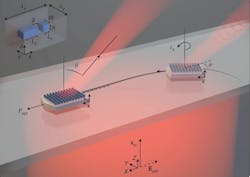A team of researchers at the Chalmers University of Technology and the University of Gothenburg (both in Gothenburg, Sweden) has demonstrated that unfocused light can be used to maneuver microscopic particles in a controlled manner.
The researchers manufactured 10-µm-wide, 1-µm-thick particles, or vehicles, that are coated with a metasurface—ultrathin arrangements of carefully designed and ordered nanoparticles tailored to direct light in interesting and unusual ways. They offer fascinating possibilities for use in advanced components for optical applications such as cameras, microscopes, and electronic displays. Usually, they tend to be thought of as stationary objects, with their use being seen as the ability to control and affect light. But here, the researchers looked at it the other way around, investigating how the forces resulting from the light’s change in momentum could be used to control the metasurface.
The researchers took their microscopic vehicles, which they termed ‘metavehicles’, and placed them on the bottom of a water dish, then used a loosely focused laser to direct a plane wave of light onto them. By a purely mechanical process—the heat generated by the light plays no part in the effect—the vehicles could then be moved in a variety of patterns. And, by adjusting the intensity and polarization of the light, the researchers succeeding in controlling the vehicles’ movement and speed with a high level of precision, navigating them in different directions and complex patterns, such as figures of eight.
“According to Newton’s third law, for every action there is an equal and opposite reaction—this means that when the light hits the metasurface, and is deflected in a new direction, the metasurface is also pushed away in the other direction. Imagine playing pool, when two balls hit each other and bounce off in different directions. In this case, the photons and the meta surface are like those two pool balls,” explains Mikael Käll, Professor at the Department of Physics at Chalmers University of Technology, who is a co-author of the article and leader of the research project.
“The metavehicles were stable, and their navigation was highly predictable and controllable. With advanced automated feedback systems, and more sophisticated control of the intensity and polarization of the source light, even more complex navigation would be possible,” explains Daniel Andrén, formerly of the Department of Physics at Chalmers and lead author of the study.
The researchers also experimented with using the metavehicles as transporters to push small particles around the tank. The metavehicles proved capable of transporting objects including a microscopic polystyrene bead and a yeast particle through the water with ease. They even succeeded in pushing a dust particle 15X the size of the metavehicle itself.
“In the exploration of optical forces, there are many interesting effects that are not yet fully understood. It is not applications that drive this type of research, but exploration of the different possibilities. In a number of different stages ahead, you never know what will happen. But the fact that we showed how the metavehicles can be used as transporters is the most initially promising potential application—for example, to move particles through cell solutions,” explains Käll.
Full details of the work appear in the journal Nature Nanotechnology.
